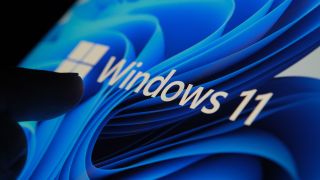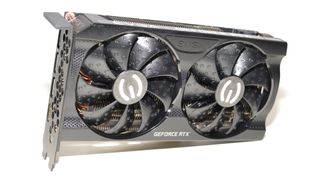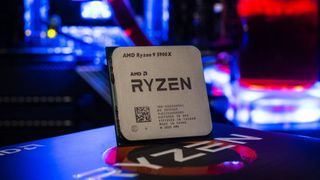Steam Survey Shows Windows 11 Accounts for 8.3% of Users
The most popular RTX 30-series GPU comes in a laptop

Valve has updated its Steam Hardware Survey with the latest data from November 2021. Perhaps the most interesting piece of information is that Windows 11 now accounts for 8.6% of all surveyed PCs, up from just 1.9% in October. We'll also look at the data on the best graphics cards and best CPUs for gaming to see what else has — or hasn't — changed.
Quick disclaimer: Valve has never fully disclosed how its sampling and data collection is done, and many have questioned its validity, but we still think the information is interesting even if we don't have confidence intervals or margins of error.
Windows 11 Picks Up Steam

The biggest news for this update is that Windows 11 usage among surveyed gamers accounts for 8.3% of all PCs. That might not seem like much, but the OS has only officially been out for two months, so that's a pretty fast uptake and more than quadruple the number of Win11 users in October. By comparison, only 2.7% of all surveyed PCs ran OSX, and 1.2% ran some flavor of Linux. Of course, Windows 11 still has a long way to go, with Windows 10 sitting at 83.4% of surveyed PCs. However, it's now surpassed Windows 7, which sits at 3.3%.
It will also be interesting to see how these breakdowns change once the Steam Deck launches. That could cause a spike in Linux usage, but Steam Machines never made much headway, and it's not clear how many Steam Decks have actually been sold.
Nvidia Continues to Dominate the GPU Landscape

Moving on to the graphics card breakdown, we're going to pull the data from Steam's API usage page, as that lets us see GPUs that account for less than 0.15% of the total. There's plenty of fuzziness in these numbers, but we've elected to use the DirectX 12 figures (which, interestingly, sum up to about 90% rather than the expected 100%). That omits a lot of older Intel GPUs, which we feel is reasonable considering the number of DX12 games and how poorly those older GPUs perform. Here's our adjusted breakdown of the numbers from the past several months.
| GPU | AUG | SEP | OCT | NOV |
|---|---|---|---|---|
| RTX 30-Series | 7.75% | 8.97% | 9.47% | 11.23% |
| RTX 20-Series | 16.11% | 14.24% | 13.63% | 13.83% |
| GTX 16-Series | 17.48% | 17.74% | 18.31% | 17.46% |
| GTX 10-Series | 26.56% | 25.48% | 24.98% | 24.48% |
| GTX 900-Series | 4.52% | 4.55% | 4.49% | 4.34% |
| RX 6000-Series | 0.43% | 0.48% | 0.51% | 0.58% |
| RX 5000-Series | 1.72% | 1.78% | 1.78% | 1.76% |
| RX Vega (and VII) | 0.82% | 0.87% | 0.86% | 0.82% |
| RX 500-Series | 4.60% | 4.68% | 4.65% | 4.56% |
| RX 400-Series | 0.78% | 0.79% | 0.79% | 0.76% |
| R9 Series | 0.37% | 0.38% | 0.40% | 0.39% |
| Vega APU | 2.55% | 2.68% | 2.72% | 2.67% |
| Intel | 3.92% | 3.92% | 3.88% | 3.73% |
We've included the past several generations, more or less, and you can see that despite some gains in overall share, Nvidia's GTX 10-series graphics cards remain the most popular GPUs by far, followed by the GTX 16-series, RTX 20-series, and RTX 30-series. AMD's most popular GPU series (on Steam) is still the RX 500 cards, which basically match Nvidia's GTX 900-series in terms of market share. The RX 6000-series, meanwhile, still accounts for a bit more than half a percent of surveyed PCs.
Nvidia's RTX 30 cards continue to gain ground, and at this rate, we can reasonably expect RTX 30 to surpass RTX 20 within the next month or two. That's despite the continued difficulty of finding any of the latest graphics cards in stock at reasonable prices. Our latest look at GPU prices on eBay indicates many models are still selling at close to double their MSRP.
Of course, that mainly applies to desktop graphics cards. While some have apparently tried to build GPU mining farms using laptops, the costs and risks of killing the hardware are too significant to go that route, so gaming laptops with the latest RTX 30 GPUs are pretty reasonably priced by comparison. Corroborating that, according to the survey, the single most popular RTX 30-series GPU is the "Nvidia GeForce RTX 3060 Laptop GPU," which now represents just over 2% of all surveyed PCs. Meanwhile, the RTX 3050 and 3050 Ti laptop GPUs only account for 0.42% and 0.38%, respectively. The RTX 3070 comes in just behind the laptop 3060, though, with 1.99% of the market.
The most popular individual GPUs continue to be the GTX 1060, GTX 1650, and GTX 1050 Ti, with the RTX 2060 coming in fourth place. Perhaps that's part of the reason we're getting an RTX 2060 12GB refresh. Hopefully, the price and availability of that part will prove to be more than a token effort to meet the demand for new graphics cards, but I'm not counting on it. AMD's single most popular GPU is still the RX 580 from 2017, coming in at position 13.
You can check the rest of the numbers yourself, if you'd like, but one final interesting piece of information is that AMD APUs with integrated Vega graphics solutions account for just 2.67% of all GPUs. Likewise, Intel graphics solutions (again, the DX12 requirement eliminates anything older than Skylake chips from 2015) represent just 3.73% of surveyed PCs. Intel might account for the largest number of graphics chips as a whole, but in terms of Steam gamers, UHD Graphics 620 only comes in 29th place. We'll see if the upcoming Arc Alchemist can do anything to change that in 2022.
AMD CPU Continue to Gain Market Share

Given Intel just launched the Alder Lake Core i9-12900K and related CPUs, they're not yet part of the survey. That should change in the coming months, but unfortunately, the Steam Hardware Survey provides virtually zero insight into what specific CPUs people are using — we don't even know the generation of CPU. What we do know is the overall market share, and we can also see data on the number of cores and clock speeds, but that's not particularly helpful given the different architectures.
That's unfortunate, as we'd love to see how Ryzen 5 5600X compares to Core i5-11400 as an example. Prior to Alder Lake, we rated Ryzen 5000 series CPUs as being the better overall choice in our AMD vs. Intel CPUs faceoff. It would be very interesting to see how many PCs are running the top-rated processors, but that's not happening.
What we do know is that AMD CPUs accounted for 31.53% of surveyed PCs, compared to 68.45% for Intel (and 0.02% for "MicrosoftXTA," a new addition to the survey). That represents a 0.69% increase in market share for AMD and a commensurate drop for Intel. Outside of an unexplained drop in August (statistical variation?), AMD CPU share has been steadily increasing for much of the past year thanks to Ryzen and Ryzen 5000 in particular.
The other data point we can gather from the CPU aspect of the survey is that the vast majority of PCs are still running 4-core and 6-core CPUs. Together, those account for 68% of all PCs, with 8-core CPUs representing another 16.5% and 2-core CPUs still surprisingly accounting for just under 12%. 10-core, 12-core, and 16-core CPUs combined only represent 2.32% of surveyed PCs, with 12-core (most likely Ryzen 9 3900X and 5900X) accounting for about half of that number.
I feel bad for anyone using a 2-core CPU, as it's been more than a decade since I regularly used a dual-core processor. Most are probably on laptops, though, which is a bit more understandable. Intel didn't move to 4-core CPUs and above as standard for its ULV parts until 8th Gen Coffee Lake parts in 2019, and Core i3 parts with only two cores are still being sold in the 11th Gen Tiger Lake family.
Stay on the Cutting Edge
Join the experts who read Tom's Hardware for the inside track on enthusiast PC tech news — and have for over 25 years. We'll send breaking news and in-depth reviews of CPUs, GPUs, AI, maker hardware and more straight to your inbox.
Jarred Walton is a senior editor at Tom's Hardware focusing on everything GPU. He has been working as a tech journalist since 2004, writing for AnandTech, Maximum PC, and PC Gamer. From the first S3 Virge '3D decelerators' to today's GPUs, Jarred keeps up with all the latest graphics trends and is the one to ask about game performance.
-
-Fran- Interesting numbers for sure. I'm still baffled the RX 400/500 series have so much of the AMD pie still. Then again, the lackluster prices for the 6K generation do not help at all; specially when those cards can still play retty much anything you throw at them (x80 with 8GB specially). Similar story with the GTX1K series. The 1060 6GB and the 1070/1080 siblings are just great cards still and that can't be denied.Reply
Looking forward to more data not only from Steam, but also computer base and other major retailers to see how everything stacks up.
Regards. -
JarredWaltonGPU Reply
One of the (many) anomalies with Steam Hardware Survey is stuff like the "Other" GPU category. Actually, this one also has "AMD Radeon Graphics" with 1.2%, with no indication what GPUs those might be. Could be RX 6600/6600 XT, could be older AMD GPUs. Who knows? That just started showing up in September, though. Anyway, it's interesting how many people apparently continue to play games via Steam with rather old and slow GPUs. There are still 1.7% of people with GTX 700-series, another 0.91% with Fermi (GTX 600/500 series), but only 0.39% with any AMD R9 GPU. Impossible to say if that's accurate or just due to the way Steam samples people.-Fran- said:Interesting numbers for sure. I'm still baffled the RX 400/500 series have so much of the AMD pie still. Then again, the lackluster prices for the 6K generation do not help at all; specially when those cards can still play retty much anything you throw at them (x80 with 8GB specially). Similar story with the GTX1K series. The 1060 6GB and the 1070/1080 siblings are just great cards still and that can't be denied.
Looking forward to more data not only from Steam, but also computer base and other major retailers to see how everything stacks up.
Regards. -
bdcrlsn Up until last year I was still running my GTX 560 Ti 448. But with new games, the 1.5GB of video memory definitely destroyed my performance. As for Windows 11, I'm "officially" out of the fold on that because my still very capable first gen Ryzen can't handle it, apparently. I know there's solutions but sometimes, you just want things to work right of the box.Reply -
escksu ReplyJarredWaltonGPU said:One of the (many) anomalies with Steam Hardware Survey is stuff like the "Other" GPU category. Actually, this one also has "AMD Radeon Graphics" with 1.2%, with no indication what GPUs those might be. Could be RX 6600/6600 XT, could be older AMD GPUs. Who knows? That just started showing up in September, though. Anyway, it's interesting how many people apparently continue to play games via Steam with rather old and slow GPUs. There are still 1.7% of people with GTX 700-series, another 0.91% with Fermi (GTX 600/500 series), but only 0.39% with any AMD R9 GPU. Impossible to say if that's accurate or just due to the way Steam samples people.
I am still using a sapphire r9 290x to game. Its coming to 8yrs old but still pretty decent at 1080p. Since i am not playing of the AAA titles, i dont need the fastest cards. -
wifiburger yeah that's interesting , but there was another report that said windows 11 is less than 1%Reply -
spongiemaster Reply
Both are right. Steam is more or less showing percentage of gaming systems which should be far higher than the overall market. I doubt there are any companies that have updated their desktops to Windows 11. None of the 100's of systems in the company I work for have been upgraded and they obviously don't have Steam installed on them either.wifiburger said:yeah that's interesting , but there was another report that said windows 11 is less than 1% -
TerryLaze Reply
Don't most high end GPUs end up in mining rigs anyway?!-Fran- said:Interesting numbers for sure. I'm still baffled the RX 400/500 series have so much of the AMD pie still. Then again, the lackluster prices for the 6K generation do not help at all; specially when those cards can still play retty much anything you throw at them (x80 with 8GB specially). Similar story with the GTX1K series. The 1060 6GB and the 1070/1080 siblings are just great cards still and that can't be denied.
Looking forward to more data not only from Steam, but also computer base and other major retailers to see how everything stacks up.
Regards.
Kinda hard to get one for gaming from what I read in the forums. -
-Fran- Reply
Hm... I would dare saying the Radeon 6K's are bad in terms of mining performance/ROI compared to the nVidia RTX 3K's, so they're not going into miner hands in bulk like nVidia GPUs do. On the lower end, I'm not sure, but the Polaris siblings and Vega cards are really good, so it's even more baffling to see them there. I'm sure most Vega's are now mining (mine is still gaming though). RDNA 1's 5K siblings are also good IIRC, but those aren't benig sold anymore anyway and by now most are probably already in miners hands.TerryLaze said:Don't most high end GPUs end up in mining rigs anyway?!
Kinda hard to get one for gaming from what I read in the forums.
Hard to say for sure, but that's what I think.
Regards. -
P1nky ReplyJarredWaltonGPU said:One of the (many) anomalies with Steam Hardware Survey is stuff like the "Other" GPU category. Actually, this one also has "AMD Radeon Graphics" with 1.2%, with no indication what GPUs those might be. Could be RX 6600/6600 XT, could be older AMD GPUs. Who knows?
AMD started identifying integrated GPUs in 4000 and 5000 Series APUs (desktop and mobile) as "AMD Radeon Graphics". What you are seeing is the iGPUs spikes in numbers because of 5700G/5600G sales.
Most Popular



